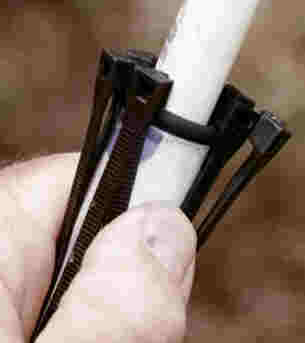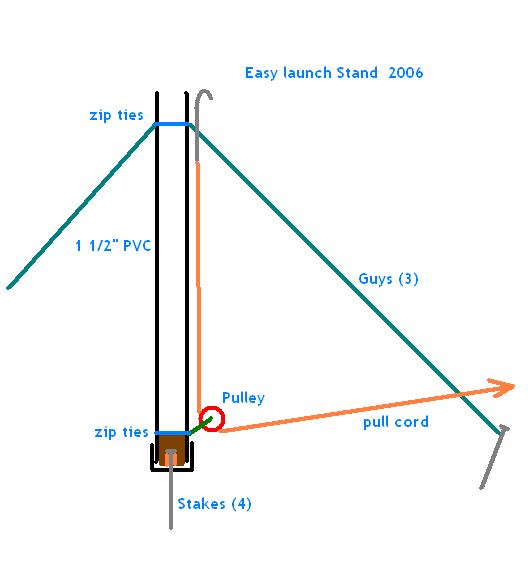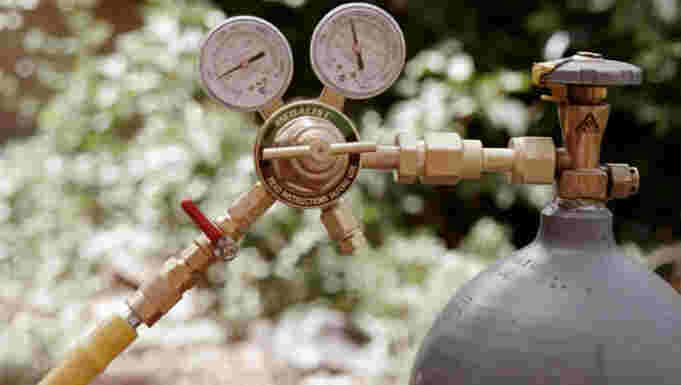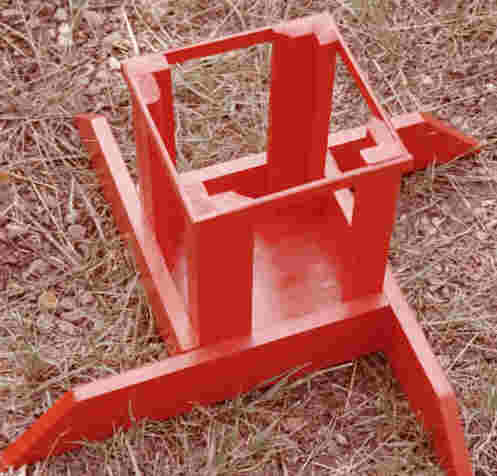A Bottled Carbon Dioxide Water Rocket Launcher
The InterPlanetary Water Rocket
Society
Gordon McDonough 12/06
This launcher was assembled with the support of
Partners
In Education, a Santa Fe based organization that directly helps school
teachers in the city with many of their classroom needs.
Thank you,
Partners!
The cool wallpaper is from the Slide
Rule Universe.
This launcher consists of four components:
The launch tube is 1/2" Schedule 40 PVC
(white),
capped on the bottom. It was cut on the top with a tubing cutter
to provide a square and smooth seat for a #94 "O" ring. I reamed
the top with an extended 5/8" spade drill bit drawn backwards into the
tube, and cemented in a length of 1/2" CPVC (tan). Dimensions
depend
on the intended rocket dimensions and the length of my long drill
bit.
Pressure is introduced through a fitting in the side. I have
padded
the bottom and the top sections of the launch tube where it fits
inside the riser with pieces of PVC so it doesn't rattle
around.
Top
 The release is a Clark Cable Tie release system, invented by Ian Clark
in Melbourne, Australia. It is quite ingenious, and is used
almost
universally by serious water rocketeers. There are details on my
front water rocket page.
The release is a Clark Cable Tie release system, invented by Ian Clark
in Melbourne, Australia. It is quite ingenious, and is used
almost
universally by serious water rocketeers. There are details on my
front water rocket page.
My current favorite stand is a 3' 4" (a
ten foot length makes three) tall piece of 1 1/4" Sched. 40 PVC pipe.
The bottom end has a block glued into it, and then I put a big spike
through a hole in an end cap and glued it on, spike facing out for a
ground stake. Three guy ropes attach near the top and are staked out
with more spikes. The pull cord passes through a pully at the bottom
and has a hook to pull on the launch tube bridle. This is the most
portable launcher I have ever used.

The pressure system includes, from right to
left, a bottle of liquefied CO2, an
adapter
to
a nitrogen purging regulator (The threads and fittings are different
for
CO2 and Nitrogen,) a 1/2" NPT ball valve (red
Handle),
a hose quick release, and a 25' pressure hose (yellow sleeve on the
end.)
 I got all the parts from the bottle to the regulator at a welding
supply
shop for about US$200. The regulator was a catalog order
item.
The rest of it came off the shelf from a Home Depot for another
$50.
In service, the tank valve is open, the output pressure is set on the
regulator
by adjusting the handle, and the rocket is pressurized by opening the
ball
valve. I close the ball valve on three during the countdown.
I got all the parts from the bottle to the regulator at a welding
supply
shop for about US$200. The regulator was a catalog order
item.
The rest of it came off the shelf from a Home Depot for another
$50.
In service, the tank valve is open, the output pressure is set on the
regulator
by adjusting the handle, and the rocket is pressurized by opening the
ball
valve. I close the ball valve on three during the countdown.
Notes: (2001)
- Different experts have told me conflicting information about the
appropriate
use of this regulator with CO2. It will
handle
much more pressure than the bottle produces, and it is rated well above
any pressure I would use, both good things. The concern arises
when
mixing gases, or more specifically, using equipment designed for one
application
for a different one. Time will tell how the regulator stands up
in
the different chemical environment of CO2. Several years and many launches later,
I have no problems to report. The regulator has held up well, and
I expect it to continue to give good service (2006).
- Because carbon dioxide under high pressure is a liquid, we must
be very
careful not to let the bottle fall over or lie on its side while in
use.
For this reason, I made a bottle stand. It is a good idea to let the CO2
settle a little while before launching.
 And now we are ready to launch.
And now we are ready to launch.
Back to the
water rocket page.
Top
My regulator is a Victor Medalist
TPR250-500-580
(Mine says P250. . .) and is capable of output pressures from 10 to 500
psi (3500 kPa). Liquid
CO2 has a vapor pressure of about 400 psi
(2750
kPa) at room temperature, and that should provide the effective limit,
although I have no reason at this time to have tried going higher than
about 150 PSI. The high side gauge reads from 0 to 4,000 psi
(28,000
kPa) and the low side from 0 to 600 psi (620 kPa) The regulator
was
manufactured by the Thermodyne Company, and there is information on
their
web site at: http://www.thermadyne.com/vec/literature/pdfs/115_65-2007.pdf
I live in New Mexico, where carbon dioxide
extraction,
a component of our natural gas industry, plays a major role in the
state
economy. After a hundred or more launches, my bottle is
still
quite heavy, I am clearly not pulling my weight!
I got all the parts from the bottle to the regulator at a welding
supply
shop for about US$200. The regulator was a catalog order
item.
The rest of it came off the shelf from a Home Depot for another
$50.
In service, the tank valve is open, the output pressure is set on the
regulator
by adjusting the handle, and the rocket is pressurized by opening the
ball
valve. I close the ball valve on three during the countdown.